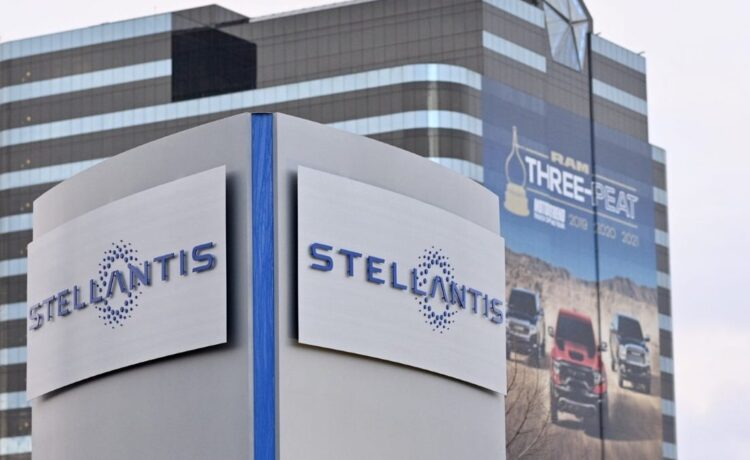Stellantis NV plans to pump $13 billion into its U.S. operations over the next four years in what the transatlantic automaker says is the largest single investment in its history.
The investment supports the introduction of five new vehicles, an all-new four-cylinder engine and more than 5,000 jobs at its facilities in Michigan, Ohio, Illinois and Indiana. The carmaker said two SUVs will now be built at a shuttered plant in Illinois, a new pickup will come to its Toledo plant, and it also identified new vehicles coming to a struggling Warren facility.
The $13 billion figure appears to incorporate most of the roughly $5 billion worth of investments Stellantis had already detailed shortly after President Donald Trump took office in January, as the carmaker sought to underscore a commitment to U.S. manufacturing, and it notably doesn’t include building any new facilities.
The changes will increase Stellantis’ annual vehicle production in the United States by half. The announcement comes as multiple carmakers, suppliers and others are under pressure from the White House to reshore production or eat costly tariffs on completed vehicles and parts; Stellantis had already disclosed it expected tariff impacts to cost it as much as $1.7 billion this year.
CEO Antonio Filosa told The Detroit News in an interview that the investments would benefit all four American brands — Jeep, Dodge, Ram and Chrysler — and beyond the five new vehicles, it would support 19 product refreshes through 2029. He added the company’s investments were expected to generate more than 20,000 additional jobs at Stellantis suppliers.
The top priority since he started as CEO in June, Filosa said, was “to grow in the largest market where we operate as a company, the market that we firmly believe will keep growing in the next years, and that represents to us a very good business.”
He added: “We obviously share President Trump’s goals to bring back jobs in U.S. plants, because we trust our people, we trust our manufacturing, the American system, and we trust our U.S. plants.”
Adding 5,000 jobs would bring Stellantis’ total U.S. workforce to around 53,000 — reversing the steady job cuts in both white-collar roles and on factory floors under former CEO Carlos Tavares over the past few years. Tavares had pushed to cut costs in the United States and shift more production to lower-cost countries.
The United Auto Workers praised Stellantis for the planned investments — and attributed them to Trump’s tariffs — after hammering the company for layoffs and going back on its promises throughout much of last year. The union said the announcement includes three additional products beyond what was already negotiated in its 2023 labor deal with the automaker.
“A year ago, Stellantis was on a fast-track to moving their U.S. operations out of the country,” UAW President Shawn Fain said. “Their decision today proves that targeted auto tariffs can, in fact, bring back thousands of good union jobs to the U.S.”
White House spokesman Kush Desai said in a statement that the Stellantis news shows how the Trump administration’s push to restore American auto manufacturing “keeps bearing fruit,” adding that it also shows confidence in Trump’s agenda and “the coming Golden Age for American industry and workers.”
The announcement Tuesday clears up lingering questions about where prominent Jeep and Ram vehicles will be built over the next few years.
It says the Belvidere Assembly Plant in Illinois will make the Jeep Cherokee and Jeep Compass starting in 2027; the automaker previously stated it would reopen the shuttered plant to make a midsize truck, but Filosa said it ultimately made more sense to put the two SUVs there, given its capacity. Belvidere’s investment is more than $600 million and will create about 3,300 jobs.
That all-new midsize Ram truck will now be built at the Toledo Assembly Complex, which will get an infusion of $400 million and add about 900 jobs. Local union officials had been making the case for the truck dating back to last year, saying they had enough capacity. It joins the Jeep Wrangler and Jeep Gladiator, which are already built there; the automaker said it’s continuing with previously-announced investments for those vehicles, and at the nearby Toledo Machining Plant.
“It’s the best news we’ve had since Stellantis took us over,” said Stephen Hinojosa, who works at the Toledo Assembly Complex.
Since the merger that formed the current company in 2021, he said the automaker steadily cut jobs at the facility, and seemed like it wanted to gradually exit the American market. “This is the first time they’ve had some significant investments,” he said, noting adding the new truck could help make up for recent slow Gladiator sales.
“It’s a win-win for everybody,” Filosa said of the automaker’s plan to switch up where it will build several prominent vehicles. “The plant that received two models instead of one, (and) Toledo, Ohio, that received one additional model, (so) we have three models instead of one, to build our plan for growth.”
At Michigan’s Warren Truck Assembly Plant, which underwent significant layoffs last year and has faced downtime and shift cuts, the automaker said a new range-extended EV and gas-powered large SUV will be introduced beginning in 2028. About $100 million will be spent on retooling that facility.
“I’m extremely ecstatic about it. It’s great not only for Warren Truck, but the future of Stellantis,” said Eric Graham, the president of United Auto Workers Local 140, which represents workers at the plant. He said UAW leadership has assured him that the Stellantis investments mean that his hundreds of laid-off members will be needed back at work within a year — though it won’t necessarily be at Warren Truck, which has recently been running on just one shift building two Jeep models.
Graham said he gives credit to Trump’s tariffs for the big investment announcement: “Without these tariffs, this probably wouldn’t have happened. I acknowledge that.”
The company will also pump $130 million into the Detroit Assembly Complex-Jefferson, where it had already confirmed it was going to build the next-generation Dodge Durango, after speculation swirled last year that the SUV could shift to a Canadian plant.
Stellantis also said it planned continued investments at its Kokomo, Indiana, facilities to make an all-new four-cylinder engine starting in 2026. That funding will tally more than $100 million and add more than 100 jobs.
Kevin Gotinsky, the UAW’s director for Stellantis, said there was already recent progress bringing members back to work. The number of indefinite layoffs was cut to 1,700 this month, he said, down from more than 3,200 in February.
Stellantis’ rivals have been making similar investment announcements. In June, for example, General Motors Co. announced plans to invest $4 billion to move production from Mexico to three plants in the United States, including its shuttered Orion Assembly plant in Metro Detroit. Ford Motor Co. announced a $2 billion investment in Louisville Assembly Plant, which will be retooled for a new all-electric midsize pickup truck to launch in 2027.
The Stellantis announcement is sure to to be considered a major victory for Trump’s trade-and-tariffs policy — and could be a harbinger of additional moves by manufacturers, foreign and domestic. Reshoring American auto jobs has been a longstanding promise from Trump, on the campaign trail in Michigan and during his two stints in the Oval Office.
Tariffs, because of their financial impact, have to play a part in any automaker’s North America product plans, said Sam Fiorani, vice president of global vehicle forecasting at AutoForecast Solutions LLC. The investments don’t involve any new auto plants, he noted, and the sites they affect had already been promised product. But the announcement does signal the significance of the U.S. market to Stellantis’ financial goals, and it will help fill a number of the automaker’s under-utilized plants that were in need of fresh product.
“The previous CEO didn’t appreciate the importance of the North American market as much as Filosa does,” Fiorani said. “Making a commitment of this size recognizes that from dealers to union members that North America is key to Stellantis’ global success.”
Stellantis’ investment announcement received widespread praise from lawmakers and other political leaders. Michigan Sen. Gary Peters, a Bloomfield Township Democrat, called it “a welcome investment in Michigan autoworkers and the future of our auto industry,” while Rep. John James, R-Shelby Township, praised Trump and said the news shows “we win by putting American workers first.”
Rep. Marcy Kaptur, a Democrat from Toledo, said the news was a “win for American autoworkers across the industrial heartland,” adding that Toledo’s “intrepid workforce has come through yet again.” Illinois Gov. JB Pritzker, meanwhile, said the investment in Belvidere would “anchor long-term economic growth, support local communities, and provide opportunities for workers and families who have historically been left behind.”
And Ohio Republican Sen. Bernie Moreno, a former car dealer, said on social media that the announcement would “never have been possible without President Trump’s America First tariffs and One Big Beautiful Bill” and that cars sold in America should be made here.



